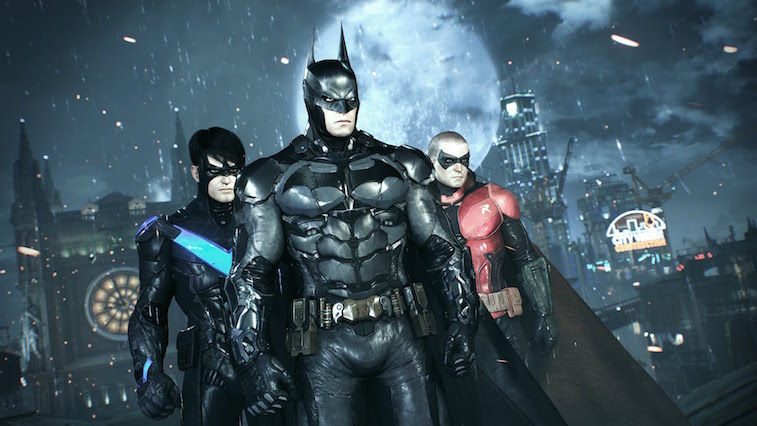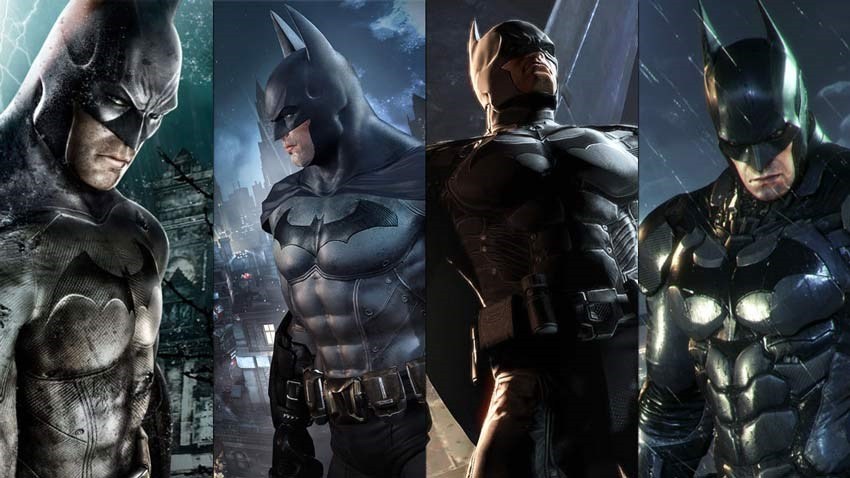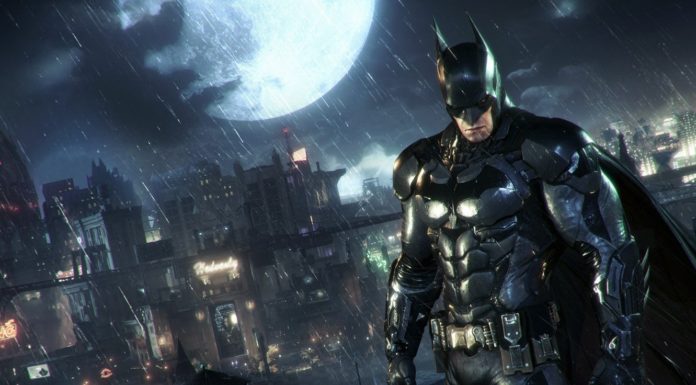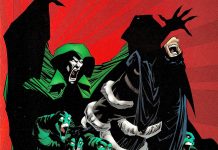EDITOR’S NOTE: The opinions expressed by BOF guest contributors are their own and do not necessarily represent those of BOF or its editor-in-chief.
Recently, BATMAN ON FILM had an interesting discussion around a poll asking us to choose our favorite non-comic book incarnation of Batman. From THE DARK KNIGHT TRILOGY to BATMAN: THE ANIMATED SERIES to 1960s TV series, it’s a tough choice for me, because I love several. It’s hard to call any of them my favorite at the expense of other iterations that I consider classic.
I first came to know Batman through Adam West, and I was the prime audience for the BTAS. And while I enjoyed the Burton/Schumacher series, Christopher Nolan’s films hit at just the right time to reignite my love for Batman as (mostly?) an adult.
So I’ve loved almost all of the adaptations of Batman in some form or another, and picking one favorite is no easy decision. They all offer various things that I love about Batman and his world.
But the Bat-Poll got me thinking: What is the most complete adaptation of Batman in a medium other than comics?
“Complete adaptation” is an important phrase here. Complete means that it includes as much of Batman’s history as it can to tell his story, and adaptation means that said history is strategically interpreted to suit the story and tone that the storyteller wants to tell. There is only one adaptation on this list that fits the bill, and it’s the one I ultimately chose:
The ARKHAM video game series.
(SPOILERS from here on out for those who haven’t played it or finished it. If that’s you, what are you waiting for?!)
 I chose it because for me, it brings the all of Batman’s world together in such a dynamic way, a way that is unique, consistent, and honors the source material. And the medium of open-world video games gives us an opportunity to explore the world in great detail, experiencing it from Batman’s perspective. And to top it off, developers Rocksteady and WB Montreal packed the world full of characters, environments, gadgets, and details to keep any fan of Batman wondering just what they’d stumble upon next. The Arkham series incorporates the most from the Batman mythos into a story and a world with a consistent tone, and it adapts those elements in a way that respects their origins and fits them into the world of the series.
I chose it because for me, it brings the all of Batman’s world together in such a dynamic way, a way that is unique, consistent, and honors the source material. And the medium of open-world video games gives us an opportunity to explore the world in great detail, experiencing it from Batman’s perspective. And to top it off, developers Rocksteady and WB Montreal packed the world full of characters, environments, gadgets, and details to keep any fan of Batman wondering just what they’d stumble upon next. The Arkham series incorporates the most from the Batman mythos into a story and a world with a consistent tone, and it adapts those elements in a way that respects their origins and fits them into the world of the series.
Nolan’s trilogy, as great as it was, didn’t include everything I would like to have seen, though that limitation was a creative choice that still worked. One of the many reasons it was great was that it was all about Bruce Wayne, and it showcased his entire arc. That meant was that we only got to see the people and events that played into that arc, the particular story that Nolan and his creative team wanted to tell. Because of that commitment, we got more exploration and development of Bruce Wayne’s character than we had ever seen. The trade-off was no portrayal of the Bat-family, no mention of several popular villains such as The Riddler or The Penguin, and no connection to a larger DC universe. Batman: The Animated Series showed more of Batman’s world and supporting characters and eventually spun off into the larger DC universe with Justice League.
But the quality wasn’t as consistent throughout, specifically when it was relaunched as The New Batman Adventures. The redesigns and different characterizations were jarring and a departure from the cinematic style of previous seasons. Still, BTAS and the entire DCAU are essential viewing for any Batman or DC fan.
As much as I love these and other iterations of Batman, the Arkham series gives me just about everything I could want in a Batman adaptation. It’s about Batman and Bruce Wayne as well, but from his perspective, and it showcases the whole Bat-family along with several more villains and connections to a larger universe. In that sense, I think the Arkham series is more complete, giving us more than we’ve ever seen of Batman’s world in a way that really works. We’ve gotten various combinations of parts of Batman’s mythos before, but to my knowledge we’ve never gotten so much in a single adaptation. In the Arkham series, we get:
 The Bat-family: Batman (obviously), Alfred, Dick Grayson as Robin and Nightwing, Jason Todd as Robin and Red Hood, Tim Drake as Robin, Barbara Gordon as Batgirl and Oracle, and her father Commissioner Gordon as well as Lucius Fox. We also get Selina Kyle/Catwoman and Talia al Ghul, and her and Bruce’s relationship is a key part of the story. I can’t recall another incarnation of Batman where all his allies and supporting characters were faithfully portrayed, alter-egos and all, and they each got to contribute meaningfully to the narrative.
The Bat-family: Batman (obviously), Alfred, Dick Grayson as Robin and Nightwing, Jason Todd as Robin and Red Hood, Tim Drake as Robin, Barbara Gordon as Batgirl and Oracle, and her father Commissioner Gordon as well as Lucius Fox. We also get Selina Kyle/Catwoman and Talia al Ghul, and her and Bruce’s relationship is a key part of the story. I can’t recall another incarnation of Batman where all his allies and supporting characters were faithfully portrayed, alter-egos and all, and they each got to contribute meaningfully to the narrative.
The world of Gotham: we get Arkham Asylum, the Batcave, Wayne Manor, GCPD, Gotham City (old and new), Iceberg Lounge, The Monarch Theater, and several appropriately-themed villain hideouts. And since these are video games, we actually get to explore them. I’ll never forget the feeling of hunting through the asylum in the first game, looking in every room, down every hallway, to see just what was there. Seeing the old Arkham Mansion, the cells where you knew Batman’s famous rogues had been housed, and getting a sense of just how much history was part of this place. I remember looking through the medical facility trying to rescue the doctors that Joker had kidnapped, and while I was looking, I noticed a whiteboard with the surgeon’s shifts listed. And what name was among those listed? None other than Dr. Thomas Elliot. I tried to explain how awesome that was to my roommates at the time, that a name on a random whiteboard meant that Hush was part of this universe (they weren’t as enthused about it as I was). I can also remember sneaking in to Bruce’s office in Wayne Tower and finding increasingly impatient voicemails from Lex Luthor, hoping to purchase outright the applied sciences division of Wayne Industries. Along with Queen Industries shipping containers and a billboard with a scarlet streak encouraging tourists to “Run to Keystone City,” we have several clues that Gotham is in a fully formed DC universe. But Gotham doesn’t get any less attention in this larger universe, and we get to go from Wayne Manor to the Batcave, to Crime Alley and the GCPD, exploring them all with hints and reminders of Batman’s history scattered throughout.
The story: specifically, how the story weaves so many parts of Batman’s history into a narrative. For those unfamiliar, the history in the Arkham series goes as far back as the 19th century, when Ras al Ghul discovered a natural source of a substance he termed “Lazarus” under Gotham City, a substance he soon found could raise the dead (which he learned from experimenting on an unfortunate Cyrus Gold, later known as Solomon Grundy). Ras then constructed a new section of Gotham called Wonder City, a futuristic crime-free utopia powered by Lazarus and the central Wonder Tower. However, proximity to Lazarus proved dangerous for the citizens of Wonder City, who began exhibiting mental distress and violent behavior. Wonder City had to be shut down and built over as Gotham City expanded, and the former citizens had to be moved to a newly opened Arkham Asylum for treatment. This was the beginning of the Arkham series’s take on this history of Gotham, which went on to detail the history of the Wayne family, their relationships with Cyrus Pinkney and Amadeus Arkham, as well as their rivalry with the Cobblepots. And the stories of each game contribute to an overall narrative that’s as compelling as any Batman story we’ve seen. In the first game, we stalk the Joker through the Asylum that he’s turned into his own personal fun house.
In the second, we find out that Hugo Strange has taken the disruptions at the Asylum as an opportunity to move all Gotham’s criminals, along with his personal enemies, to a quarantined area of Old Gotham in order to systematically kill them all (to top it off, Joker has poisoned Batman with disease that he inadvertently infected himself with during the first game, and Batman must find a cure while stopping Strange). At the end of the game, we learn that Ras al Ghul was the true mastermind, continuing his plans from centuries earlier to take control of Gotham and eliminate crime. Batman stops Ras and Strange, and seemingly cures himself, however Ras, Strange, Talia, and Joker all die.
In Arkham Origins, we get to experience Batman’s early career and his first interactions with the Joker, setting the stage for their perpetual conflict.
 And in the final game, while Gotham is threatened by Scarecrow, Batman is threatened externally by a mysterious Arkham Knight and internally by Joker’s infection, manifested as Joker himself gaining control over Batman’s mind, a brilliant story twist that can only be experienced in a video game. We learn that the Arkham Knight is none other than a presumed-dead Jason Todd, tortured and manipulated by The Joker years prior just as Batman is tortured internally. Batman manages to defeat Scarecrow and The Joker lurking in his mind, while bringing Jason Todd back from the brink. However, the world learns that Batman is Bruce Wayne, and the game ends ambiguously, with Bruce appearing to have killed himself and a mysterious Bat-creature hunting the criminals of Gotham.
And in the final game, while Gotham is threatened by Scarecrow, Batman is threatened externally by a mysterious Arkham Knight and internally by Joker’s infection, manifested as Joker himself gaining control over Batman’s mind, a brilliant story twist that can only be experienced in a video game. We learn that the Arkham Knight is none other than a presumed-dead Jason Todd, tortured and manipulated by The Joker years prior just as Batman is tortured internally. Batman manages to defeat Scarecrow and The Joker lurking in his mind, while bringing Jason Todd back from the brink. However, the world learns that Batman is Bruce Wayne, and the game ends ambiguously, with Bruce appearing to have killed himself and a mysterious Bat-creature hunting the criminals of Gotham.
The design: Each character and location is a blend between their comic book roots and a commitment to realism in the tradition of the animated series and the Nolan trilogy. Arkham Asylum is a fully realized place, with a classic Victorian design that was partially retrofitted into a treatment facility, a perfect locale for the madness of Batman’s villains.
In Gotham City, we get the old and new, with modern skyscrapers from which we can see the oldest parts of Gotham, including the Monarch Theater and Crime Alley. And we get to glide around these places as Batman, running from rooftop to rooftop, or using the Batwing in Arkham Origins and the Batmobile in Arkham Knight. The Gotham of the Arkham series is Gotham City for me, because I’ve been there. The character design is equally brilliant. The Batsuits are some of the best ever, and giving Robin a hood was a stroke of genius.
Matt Reeves, take all the inspiration you want from this series. Especially the villains’ designs, which for many of them is the best they’ve ever looked. Oswald Cobblepot, permanent glass bottle monocle and all, is the perfect realization of a deranged gangster with enough dramatic flair to carry around deadly umbrellas. The Riddler’s slovenly appearance honors his comic origins and reflects his obsession with besting Batman. Victor Fries is a tragic ally outside of his suit, but once he wears it, he becomes a horrific monster akin to a Big Daddy from the Bioshock series. Each character is an inspired take that draws from their comic appearance, but one that fits brilliantly into a world and a tone committed to the a slightly more fantastic version of the hyper-realism of Nolan’s trilogy. In other words, the design is absolutely perfect for Batman’s world, at least as far as I’m concerned.
The Arkham series combines all these elements in a way no other iteration has managed. Every meaningful part of Batman’s history is represented, small or large. And for me, that’s why I consider it the most complete adaptation of Batman to date.
So what do y’all think? Is there a more complete adaptation of Batman that I’m overlooking? Am I being way to kind to the Arkham series? Did it leave something out that you think should always be part of Batman’s story? Or do you love it as much as I do? Let me know in the comments below, or hop over to the BOF Facebook Group and let’s hear what you have to say! – Trey Jackson













